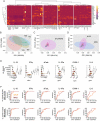Discrimination of COVID-19 From Inflammation-Induced Cytokine Storm Syndromes Using Disease-Related Blood Biomarkers
- PMID: 33880885
- PMCID: PMC8251089
- DOI: 10.1002/art.41763
Discrimination of COVID-19 From Inflammation-Induced Cytokine Storm Syndromes Using Disease-Related Blood Biomarkers
Abstract
Objective: Infection with the novel coronavirus SARS-CoV-2 triggers severe illness with high mortality in a subgroup of patients. Such a critical course of COVID-19 is thought to be associated with the development of cytokine storm, a condition seen in macrophage activation syndrome (MAS) and secondary hemophagocytic lymphohistiocytosis (HLH). However, specific data demonstrating a clear association of cytokine storm with severe COVID-19 are still lacking. The aim of this study was to directly address whether immune activation in COVID-19 does indeed mimic the conditions found in these classic cytokine storm syndromes.
Methods: Levels of 22 biomarkers were quantified in serum samples from patients with COVID-19 (n = 30 patients, n = 83 longitudinal samples in total), patients with secondary HLH/MAS (n = 50), and healthy controls (n = 9). Measurements were performed using bead array assays and single-marker enzyme-linked immunosorbent assay. Serum biomarker levels were assessed for correlations with disease outcome.
Results: In patients with secondary HLH/MAS, we observed pronounced activation of the interleukin-18 (IL-18)-interferon-γ axis, increased serum levels of IL-1 receptor antagonist, intercellular adhesion molecule 1, and IL-8, and strongly reduced levels of soluble Fas ligand in the course of SARS-CoV-2 infection. These observations appeared to discriminate immune dysregulation in critical COVID-19 from the well-recognized characteristics of other cytokine storm syndromes.
Conclusion: Serum biomarker profiles clearly separate COVID-19 from MAS or secondary HLH in terms of distinguishing the severe systemic hyperinflammation that occurs following SARS-CoV-2 infection. These findings could be useful in determining the efficacy of drugs targeting key molecules and pathways specifically associated with systemic cytokine storm conditions in the treatment of COVID-19.
© 2021 The Authors. Arthritis & Rheumatology published by Wiley Periodicals LLC on behalf of American College of Rheumatology.
Figures


References
-
- Sinha P, Matthay MA, Calfee CS. Is a “cytokine storm” relevant to COVID‐19? [editorial]. JAMA Intern Med 2020;180:1152–4. - PubMed
-
- Force AD, Ranieri VM, Rubenfeld GD, Thompson BT, Ferguson ND, Caldwell E, et al. Acute respiratory distress syndrome: the Berlin Definition. JAMA 2012;307:2526–33. - PubMed
Publication types
MeSH terms
Substances
Grants and funding
LinkOut - more resources
Full Text Sources
Other Literature Sources
Medical
Research Materials
Miscellaneous

